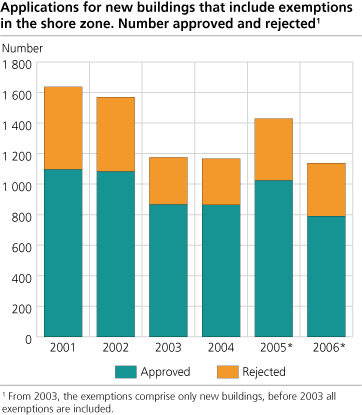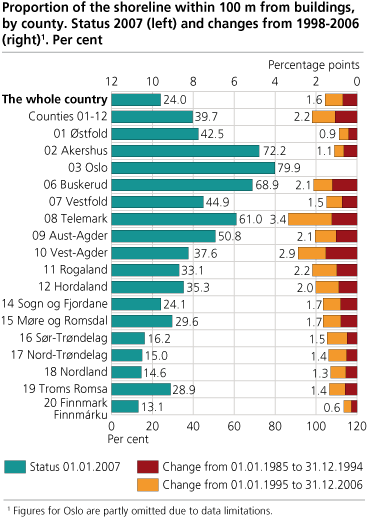Content
Published:
This is an archived release.
Slowly shrinking
A bit fewer buildings were constructed during 2005 than the year before, but the building activity outside of urban settlements did not decrease. However, less applications for building in the shore zone was granted in 2006 compared with previous years.
Targets and key figures for the environmental policyEveryone shall have the opportunity to take part in outdoor recreation as a healthy and environmental sound leisure activity that provides a sense of well - being , both near their homes and in the countryside . This is the strategic objective for the target outdoor life in the Norwegian environmental policy. In this aspect the shore zone is very valuable, offering opportunities for outdoor recreation. At the same time these areas are under great pressure from developments that are restricting the public access to the areas. § 17-2 of the Planning and Building act is also restricting developments in the shore zone. |
After an increase from 2003 to 2004, there was a small drop in construction activity in the shore zone in 2005. There has however been a slightly increased construction activity outside of urban settlements each year since 2003. Urban settlements are already built-up, and continued building activity inside urban settlements does not influence the coast line further (according to the definitions employed).
As of January 1st 2007 there were 450 000 buildings within 100 meters from the shoreline (all islands included). This represents 12 per cent of all buildings in Norway. Most of the buildings are boat-houses or garages, while dwellings and holiday homes are the second and third most common building type in the shore zone.
Fewer dispensations granted
The municipalities received 27 per cent fewer dispensation applications in 2006 compared with the previous year. Around 790 dispensation applications were granted in comparison with 1 024 in 2005. The number of dispensation granted in 2006 is the lowest since the statistics was established in 2001.
The municipalities also granted a somewhat lower proportion of the applications than the year before. The dispensations comprised 69 per cent of all applications in 2006, while the corresponding figure for 2005 was 72 per cent.
Continued rise in building influence
In spite of a decrease in building activity in the shore zone, the proportion of the building-influenced shoreline has increased. This increase comes as a result of more shore zone building activity outside of urban settlements.
The highest proportion of building-influenced shoreline is in the counties Akershus, Oslo, Buskerud and Telemark, while the biggest increase has been in the counties Telemark, Vest-Agder, Rogaland and Aust-Agder. During the period 1985-2007, the proportion of building-influenced shoreline increased by 1.6 percentage points for the country as a whole.
Highest pressure around the large cities
The highest proportion of shoreline less than 100 metres from buildings, are in and around the large cities. The results are presented by centrality. That is, each municipality in Norway has been classified according to travel time to the closest urban settlement over a certain size. The central municipalities have more of the shoreline influenced by buildings than less central municipalities. 39.4 per cent of the shoreline in the central municipalities is less than 100 metres from a building, while the corresponding figure for the least central municipalities are 17.8 per cent. Also in the time period from 1985 to 2007, the building activity has been higher in more central municipalities compared to less central municipalities. Granted dispensation applications are also densest in the central areas.
More developed in the mainland
A higher share of the shoreline (islands with bridge or tunnel to the mainland included) was within 100 metres from buildings in the mainland as compared to islands. 38.2 per cent of the mainland shoreline was influenced by buildings. The development in the period 1985 - 2007 was also faster in the mainland (2.4 percentage points increase). Of the mainland shoreline in the counties from Østfold to Hordland, 54.2 per cent had buildings within 100 metres.
Changes since last publicationFrom this year onwards the “date for the start of building construction” is used instead of “date of first use” as previously used. All previous years are recalculated. |
Tables:
Contact
-
Tom Anders Engebakken
E-mail: tom.engebakken@ssb.no
tel.: (+47) 47 46 47 66
-
Jørn Kristian Undelstvedt
E-mail: jorn.kristian.undelstvedt@ssb.no
tel.: (+47) 94 50 68 64



